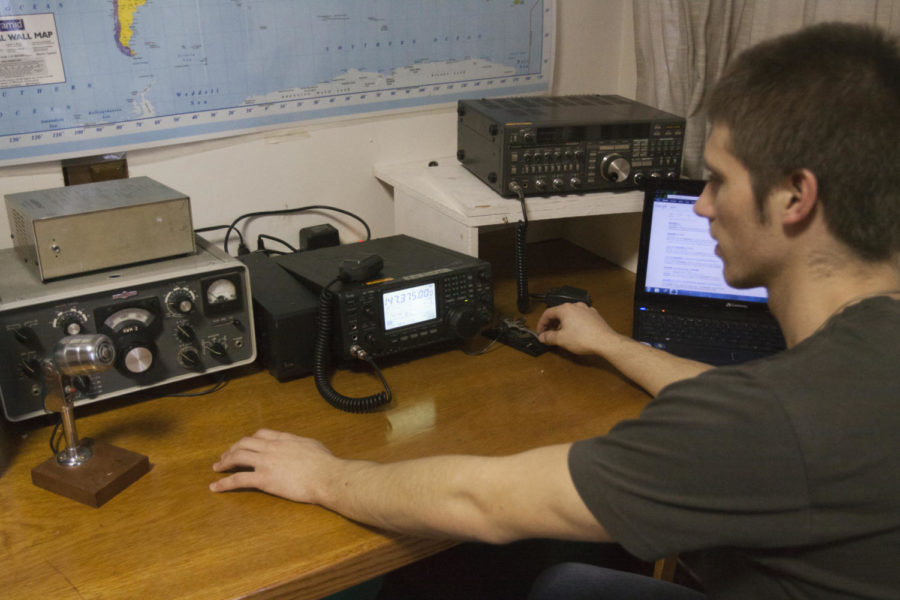100 plus years of amateur radio broadcast
Ethan Crane / Iowa State Daily
Wyatt Hagen, president of the Cyclone Amateur Radio Club, taps out a morse code signal on an antique radio on Feb. 7.
February 8, 2013
Amateur radio began more than 100 years ago at Iowa State.
With its first transmission of Morse code in 1911, the event led to the existence of WOI radio and ultimately changed the history of broadcast.
The history of ISU amateur radio, also known as ham radio, is described as a technological revolution by Jeff Stein, who is an Iowa broadcasting historian, author and a former lecturer at Iowa State’s Greenlee School of Journalism and Communication.
“The fact that Iowa State was one of the first places to pay attention to this technology that ultimately revolutionized our lives in the 20th century is important because it shows that Iowa State has consistently been dedicated to being first in developing communication technologies,” Stein said.
For Wyatt Hagen, president of the Cyclone Amateur Radio Club, the significance of the radio history is great.
“I think it’s a big deal for the campus because it’s 100 years of the campus working toward and celebrating the early achievements that Iowa State made in developing radio communication,” Hagen said.
The communication systems were quickly evolving and Iowa State was one of the pioneers in the amateur radio development.
“The next step in the evolution was to see if you could send those dots and dashes, the Morse code, through the air — wireless,” Stein said.
The concept of ham radio started as an experiment done by a physics professor, “Dad” Hoffman, and the engineering department from 1911 to 1913 in hopes to send signals.
Iowa State received an amateur radio operation license from the U.S. Department of Commerce in Washington in August 1912.
Consequently, the call sign 9YI was generated for the Iowa State amateur radio.
A call sign is used as an identifier for every radio station while communicating messages on-air.
Each radio station has their own globally unique call sign.
“9YI could actually reach hundreds of miles from central Iowa and, by 1913, 9YI was on a regular basis sending out weather reports by Morse code,” Stein said.
The 9YI call sign led to the birth of WOI, hence evolving into today’s WØISU and WØYI.
“Through Iowa State College’s efforts with 9YI, they could tap out on a schedule the Morse code, the dots and dashes flying through the air giving information to people who might be on the rural areas on the farm and not be near a wire-receiving station,” Stein said.
In November 1921, the ham radio sent music, which earned them a license to become WOI radio in 1922.
WOI radio is still owned by Iowa State.
This foundation of amateur radio as described by Hagen is “a stepping stone to new technology.”
The ISU amateur radio has set a solid foundation to radio as we know it today.
“The experiment in 1911, 1912, 1913 laid the foundation for the radio that we know today, absolutely,” Stein said.
The Cyclone Amateur Radio Club, which uses the WØISU and WØYI call signs, is a student-run organization that provides the facility for amateur radio and is open to anyone.
“It’s not specially an engineering club,” Hagen said.
The club participates in activities including civil services, sky warns, communication with people via radio across the world, contesting and developing new technologies.
“The fact that it has existed a 100 years means that amateur radio as itself must be something valuable; it didn’t just come and go, it’s been around,” Hagen said.

















